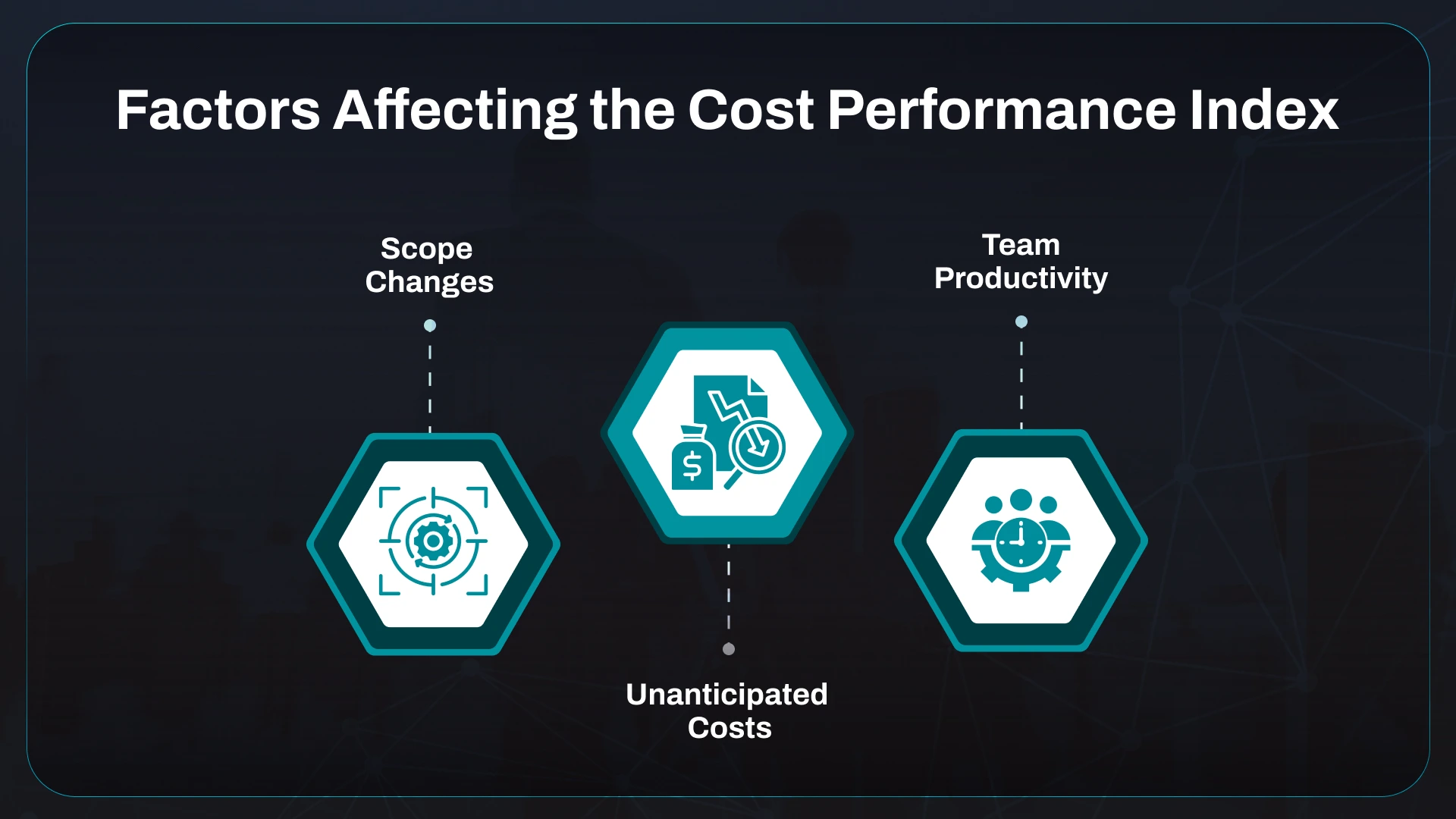
Everything You Need to Know About the Cost Performance Index in Project Management
Maintaining control over time and budget is important to project management success. However, many projects face significant budget overruns. Nearly 70% of projects fail to meet their original cost estimates.
This is where the cost performance index (CPI) becomes invaluable. CPI is a metric that helps project managers understand how efficiently their budget is used by comparing the work completed to the actual cost incurred.
When CPI is tracked properly, it offers insight into whether a project is under budget, on track, or overspending. According to a study by the Project Management Institute (PMI), projects with effective earned value management (EVM) — which includes tracking CPI — are 40% more likely to be successful.
Understanding and applying CPI isn’t just about balancing the books; it’s about gaining real-time control over a project’s cost efficiency. Without it, project teams risk mismanaging their resources and facing preventable delays.
What is the Cost Performance Index (CPI)?
The cost performance index (CPI) is a critical metric in project management used to measure a project’s cost efficiency as it progresses. It is part of the earned value management (EVM) framework and calculated by dividing the earned value (EV) of the work performed by the actual costs (AC) incurred.
The formula for CPI is:
CPI = AC / EV
Where:
- Earned Value (EV) tells you how much work has been done regarding the project’s budget. It’s like asking, “Based on the budget, how much should this completed work be worth?”
- Actual Costs (AC) show the money spent to complete that work. Essentially, they are the actual cost of completing the work at this stage.
By monitoring CPI, stakeholders can predict cost overruns early and make informed decisions to keep the project financially on track.
Also Read: 10 Earned Value Management Formulas to Know for Project Management
How is the Cost Performance Index Used in Project Management?

Here’s how CPI is used in practice:
1. Budget Performance Tracking
CPI shows how efficiently the project spends its budget. A CPI of 1.0 means the project is on track—spending matches the earned value of the work completed. A CPI greater than 1.0 means the project spends less than planned, indicating cost efficiency. Conversely, a CPI below 1.0 signals overspending, requiring immediate attention.
2. Forecasting Project Costs
By analyzing the CPI at various stages, you can forecast whether the project will stay within budget by the time it’s completed. A continually declining CPI warns of cost overruns, helping managers take corrective action early.
3. Decision-Making
The CPI assists decision-making by providing a clear picture of financial health. If the CPI indicates cost inefficiency, you can reassess resource allocation, adjust timelines, or negotiate with stakeholders to recalibrate the project scope or budget.
4. Progress Reporting
CPI is used in status reports to communicate the project’s financial health to stakeholders. It provides a quick, quantifiable measure of how well the project adheres to its budget, allowing stakeholders to gauge the overall performance.
The Relationship Between CPI and Earned Value Management (EVM)
The cost performance index (CPI) is a significant metric in the earned value management (EVM) system, a widely used project management methodology that integrates cost, schedule, and scope. It provides a comprehensive view of how much work has been completed (earned value) compared to the planned work and the actual costs incurred. Using EVM, you can identify potential issues early and make informed decisions to keep the project on track.
Here’s how CPI ties into the larger EVM framework:
- Financial Performance Metric: CPI provides a snapshot of cost efficiency, a core component of EVM’s project progress evaluation. Without CPI, project managers would struggle to quantify cost-related performance within EVM.
- Comprehensive Project Control: In the EVM system, CPI works alongside the Schedule Performance Index (SPI) to give a complete picture of financial and time-based project efficiency. Together, they help identify whether the project is on track to meet its cost and schedule targets.
- Performance Measurement: CPI is essential for measuring a project’s financial performance. It helps project managers assess whether they are spending wisely relative to the work accomplished. A CPI greater than 1 indicates effective cost management, while a CPI less than 1 indicates a need for corrective action.
- Forecasting: By analyzing CPI trends over time, project managers can make better forecasts regarding future performance and potential budgetary issues. If the CPI shows a downward trend, it could signal the need to adjust project plans to avoid exceeding the budget.
- Decision-Making: CPI, as part of EVM, provides critical data for decision-making. Project managers can identify areas of cost inefficiency and take corrective actions, such as reallocating resources or revising project scopes to bring costs back in line.
- Accountability: Utilizing CPI in EVM promotes accountability among team members. When everyone understands how their work impacts the project’s cost performance, they are more likely to be mindful of their spending and resource usage.
In short, CPI is an essential cost-efficiency indicator within the EVM framework, ensuring that project managers have the correct data to maintain budgetary control and steer the project toward success.
Some other related metrics include:
| Metric | Description | Relevance to EVM |
| Schedule Performance Index (SPI) | Measures how efficiently time is being used on the project. Calculated as EV / Planned Value (PV). | SPI indicates if a project is ahead or behind schedule, complementing CPI for overall project health. |
| Planned Value (PV) | The estimated value of work planned to be completed by a specific time. | PV serves as a baseline to compare actual performance against project plans. |
| Earned Value (EV) | The value of work actually completed at a specific point in time. | EV provides a quantifiable measure to assess project progress and is crucial for CPI calculations. |
| Actual Cost (AC) | The total cost incurred for work completed at a specific point in time. | AC is essential for calculating CPI and determining whether a project is under or over budget. |
| Cost Variance (CV) | Measures the difference between EV and AC. | CV helps in assessing financial performance by indicating how much the project is under or over budget. |
| Schedule Variance (SV) | Measures the difference between EV and PV (SV = EV – PV). | SV highlights schedule performance, helping to understand deviations from the planned timeline. |
| Forecasted Completion Cost (FCC) | An estimate of the total costs required to complete the project based on current performance metrics. | FCC helps project managers adjust forecasts and budgets in response to current CPI and other metrics. |
Factors Affecting the Cost Performance Index

The cost performance index (CPI) is influenced by several important factors that can significantly impact a project’s financial health. Understanding these factors is essential for project managers aiming to maintain cost efficiency and ensure project success.
1. Scope Changes
Scope changes, often called “scope creep,” occur when unplanned modifications to the project’s deliverables occur. These changes can arise from client requests, stakeholder inputs, or evolving market conditions. Scope changes typically lead to:
- Increased Costs: When a project’s scope expands, additional resources, time, and effort are usually required, leading to increased costs. For instance, if a new feature is added to a software development project, it may necessitate hiring additional staff or extending timelines, which directly affects the actual cost (AC) and can lower CPI.
- Budget Realignment: Project managers may need to adjust the budget to accommodate the new scope, which could alter the original earned value (EV) calculations. Misalignment can result in misleading CPI figures if not accurately tracked and reported.
2. Unanticipated Costs
Unanticipated costs can arise from various sources, such as material price fluctuations, unexpected labor expenses, or unforeseen regulatory compliance costs. These costs can impact CPI in several ways:
- Impact on AC: Any unexpected expense adds to the actual cost (AC) without a corresponding increase in earned value (EV), resulting in a lower CPI. For instance, if a project incurs an unplanned expense of $10,000 for additional equipment but does not produce additional value, the CPI will reflect this inefficiency.
- Potential Misinterpretation: Project managers must accurately account for unanticipated costs so CPI can represent the project’s financial health. Stakeholders might interpret a lower CPI as a lack of efficiency, unaware that external factors contributed to the cost overruns.
3. Team Productivity
Team productivity is an essential factor that directly influences CPI. High-performing teams tend to complete tasks more efficiently and within budget, while low productivity can lead to delays and increased costs. Here’s how team performance impacts CPI:
- Efficiency: A well-functioning team that communicates effectively and works collaboratively can achieve more in less time, leading to higher earned value (EV) relative to actual costs (AC) and a higher CPI.
- Motivation and Morale: Team morale can affect productivity levels. A motivated team will likely work efficiently and meet project goals, while a demotivated team may experience lower output, directly impacting CPI.
How Can You Improve Your Project’s Cost Performance Index?

1. Budget Management Strategies
Effective budget management is crucial for improving the project cost performance index (CPI). Establishing an accurate budget from the outset allows project managers to set realistic cost expectations. Regularly reviewing and updating budget estimates ensures they reflect actual project progress.
According to a report by the Project Management Institute, projects that employ effective budgeting techniques tend to have better performance outcomes, including a 12% increase in successful project delivery. Using budgeting software can simplify tracking expenses and ensure that budget adjustments are made promptly to reflect any changes in scope or resource allocation.
2. Monitoring and Control
Continuous monitoring and control are important for maintaining a healthy CPI. Implementing project management software with real-time tracking capabilities allows you to monitor expenditures and compare them closely against the planned budget.
3. Proactive Problem Solving
Identifying inefficiencies and potential risks early in the project lifecycle can significantly enhance CPI. By conducting regular team reviews and utilizing techniques like root cause analysis, project managers can uncover underlying problems before they translate into costs. Training team members to recognize and report inefficiencies encourages a culture of proactive problem-solving.
According to research from the Project Management Institute, projects that engage in early risk identification and mitigation strategies are 20% more likely to finish on time and within budget. By addressing issues early, teams can implement solutions that improve CPI and overall project performance.
Don’t Let Cost Overruns Derail Your Projects—Team Up with ProboData!

Maximizing your cost performance index (CPI) is crucial for delivering successful projects within budget and on time. ProboData‘s evData Pro, an add-on to Deltek Cobra, offers a powerful solution to streamline your earned value management, ensuring you stay ahead in today’s competitive project management environment.
With evData Pro, you can take advantage of:
- Real-Time Tracking: Gain immediate insights into project metrics, allowing quick decision-making to keep costs in check and projects on schedule.
- Comprehensive Reporting: Access in-depth analyses highlighting project performance, enabling you to make informed adjustments that enhance efficiency.
- User-Friendly Interface: Benefit from an intuitive design that empowers your team to engage with the tool effortlessly, fostering collaboration and productivity.
- Customizable Dashboards: Tailor metrics to your project’s needs, ensuring critical information is easily accessible to all stakeholders.
Integrating evData Pro into your project management toolkit can transform how you approach CPI, driving better results and enhancing accountability. Ready to revolutionize your project management practices?
Contact us to learn how evData Pro can improve your projects.
